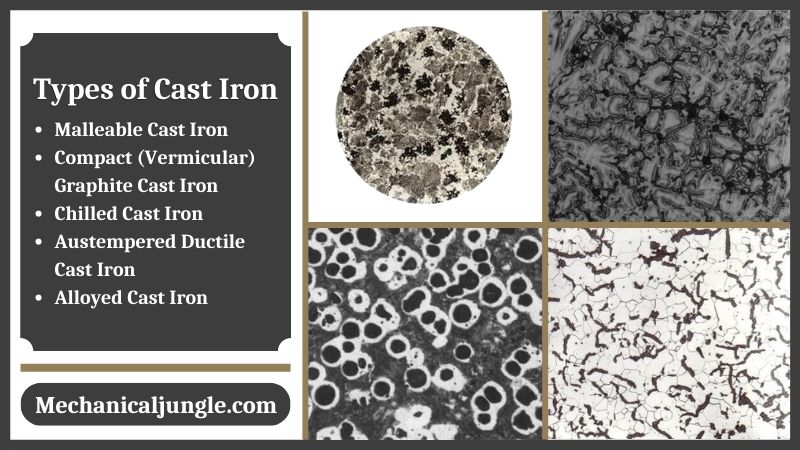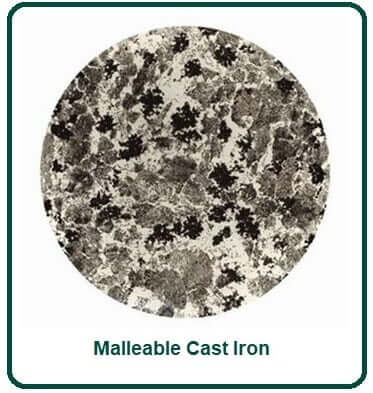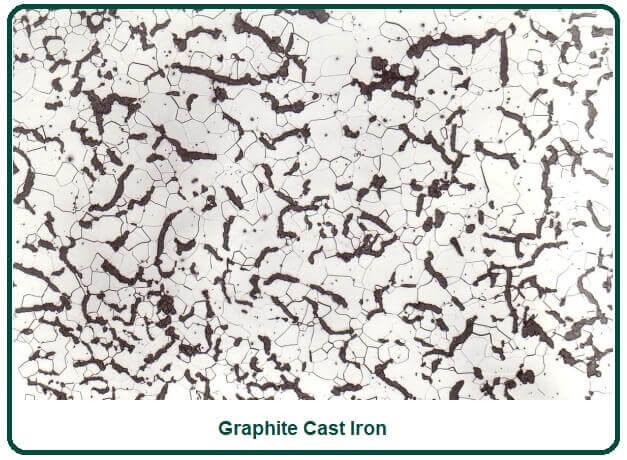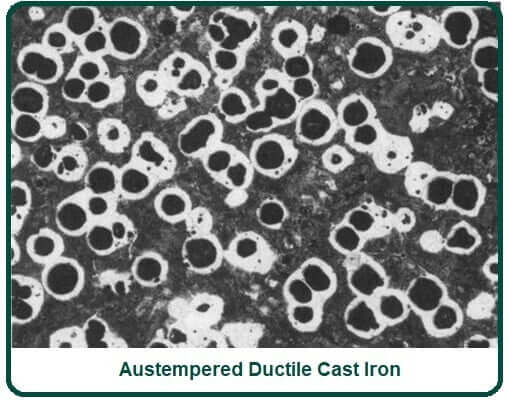
What Is Cast Iron Material?
Cast iron material is a group of carbon alloys containing 2 to 4% carbon and varying amounts of silica and manganese. It also contains impurities such as phosphorus & sulfur.
It is produced by reducing iron ore in blast furnaces, and its primary material is cast iron produced from molten iron ore in the furnace. These irons are made directly from molten pig iron or by smelting pig iron, often with a substantial amount of iron, limestone, steel, or coke.
It can be melted in a special type of blast furnace called a cupola but is most often melted in an electric induction furnace or an electric arc furnace.
As mentioned earlier, cast iron is made from pig iron, limestone, and coke. This manufacturing process takes place by melting those three ingredients in a cupola furnace. The cupola furnace is more or less similar to the blast furnace.
It is cylindrical in shape and has a diameter of about 1 m and a height of about 5 m. The material is poured from the top of the furnace and then heated. At this point, the impurities in the pig iron are somewhat removed by oxidation which forms the molten iron.
The slag is then removed from the top of the molten iron at regular intervals. The molten iron is then poured into a mold to form the required shape.
Cast iron is a brittle & less ductile material with high corrosive strength. Due to its high compressive strengths, it is used to form the base or body of most machines.
Cast irons also have a low melting point of around 1200°C which makes them suitable for casting. It is called cast iron because of its casting properties. It has low manufacturing costs and has excellent machining properties.
Differences Between Cast Iron and Cast Steel
One of the most popular way to make permanent and quality components are through casting. Casting allows a higher level of detail, resulting in no need for further fabrication or assembly.
While many different materials can be casts, steel and iron are two of the most popular for most applications due to their excellent mechanical properties.
Cast iron generally refers to gray iron, ductile iron, and malleable iron, which is an iron casting with a carbon content of more than 2%.
Cast steel generally refers to ordinary carbon steel and alloy steel, which is a steel casting with carbons contents of less than 2%. Therefore, there is no major difference between chemical content and raw material for cast iron vs cast steel.
#1. Corrosion Resistance
When it comes to corrosion, irons have better corrosion resistance than steel. That doesn’t mean it’s impervious to corrosion either.
When lefts unprotected, both metals will oxidize in the presence of moisture. Eventually, they will disintegrate completely. To prevent this, the coatings are recommended for both steel & irons castings.
#2. Cost
Cast iron is often cheaper than casts steel because of the lower materials cost, energy, and labor required to produce the final product. While cast steel is more expensive, however, there are prefabricated forms of steel. These include sheet, rod, bar, tube, and beam.
#3. Castability
Cast irons are relatively easy to cast, as it flows easily and does not shrink as much as steels. This flowability makes cast irons an ideal metal for architectural or ornate iron structures such as fencing and street furniture.
Types of Cast Iron
There are four main types of cast iron, as mentioned below:
#1. Malleable Cast Iron

Malleable iron is a class of cast iron with mechanical strength properties that are intermediate between gray and ductile cast irons.
Microstructures provide properties that make malleable irons ideal for applications where rigidity and machinability are required and for components that require some ductility or be malleable so that they bend or flex under conditions without cracking.
It can be done. They are often used as the materials of choice for small castings with thin cross-sections or for castings that, among other irons, are cooled carbides on the surface due to faster cooling rates in thinner sections.
Another important aspect is that malleable properties can be present up to the surface of the casting, unlike ductile iron, where the cast surface may have flake or deformed graphite, creating a stronger casting. Malleable cast iron is produced by heat-treating white cast iron.
Iron carbide decomposes into iron & carbon under certain conditions. These decompositions reaction is favored by high temperatures, slow cooling rates, & high carbon and silicon content.
At room temperature, the microstructure consists of carbon nodules tempered in the ferrite matrix, commonly referred to as ferritic ductile cast iron resulting in superior ductility.
Graphite nodules also serve to lubricate the cutting tool, which is responsible for the very high machinability of malleable cast iron.
Ferritic malleable cast irons have been widely used for automotive, agricultural, & railroad equipment; Expansion joints and handrail castings on bridges; chain-hoist assembly; industrial casters; pipe fittings.
#2. Compact (Vermicular) Graphite Cast Iron

Compact graphite iron CG iron is a type of cast iron with properties between flake & nodular graphites cast irons. It is of interest because of its useful combinations of strengths, thermal conductivity, and other properties.
Their production requires the same controls as those applied in the manufacture of ductile iron castings. It is recommended to add a high-efficiency inoculant for the production of CG iron.
A high level of inoculant addition results in a fine distribution of compacted graphite throughout the casting and low sensitivity to carbide formation.
Although graphite particles are long and randomly oriented like gray iron, they are shorter and thicker and have rounded edges. Furthermore, while the compressed graphite particle shape may appear worm-like when viewed over a cross-section, the ‘worms’ are actually interconnected.
This complex graphite morphology, with irregularly rough surfaces, results in strong adhesion between the graphite and iron matrix, and inhibits both cracks initiation & propagation, and is the source of superior mechanical properties relative to gray cast iron.
#3. Chilled Cast Iron

When a localized area of cast iron cools much faster than the melt, carbides are formed. This type of cast iron is called cold iron.
Adjusting the carbon composition of white CI can produce a cold iron casting so that the normal cooling rate at the surface is fast enough to produce carbide, while a slow cooling rate below the surfaces will produce gray or ductile irons.
The depth of the refrigerant decreases, and the hardness of the cold zone increases as the carbon content increases. Chromium is used in smalls amounts (1 to 4%) to control the depth of freezing, increase hardness, and improve abrasion resistance.
#4. Austempered Ductile Cast Iron

High-strength grades of ductile iron can be quenched & tempered to form a bainite-like matrix produced by austempering.
Austempered Ductile Irons (ADI) provide twice the strength of conventional ductile iron at a given level of ductility. ADI can have strengths in excess of 230 ksi (1,586 MPa); However, its modulus is 20% less than that of comparable strength steel.
The automobile industries have made good use of austempered ductile CI. It is used for the crankshaft in some sports cars. It is reported to have excellent fatigue properties, & its damping characteristics reduce engine noise. ADI is a versatile material.
Specific sets of properties can be achieved by selecting precise heat treatment parameters. Low-rigidity eddy castings are used in structural applications, often where weight and cost reduction are important.
The wear resistance at any hardness level is superior to that of steel, making higher hardness grades ideal for mining, construction, agriculture, and similar high-abrasion applications.
#5. Alloyed Cast Iron

These irons are classified into two types: corrosion-resistant and elevated-temperature service. Corrosion-resistant alloyed cast irons are used to produce parts for engineering applications that operate in environments such as seawater, fine citrus oils, commercial organic and inorganic acids, & alkalis.
Elevated-temperature service alloyed iron resists fractures under service load, oxidation by the ambient environment, structure enhancement, and instability up to 1,100 °F (600 °C).
The complex shape and ability to machine alloy irons make them an attractive material for the production of components in chemicals processing plants, petroleum refining, food handling, & marine service.
High chromium-containing CI is used in situations where high wear resistance is desirable, such as during the crushing of rocks and minerals. Iron consists of a combination of alloying elements such as Cr, Mo, and Ni, forming very strong carbides.
Welding of Cast Irons
Cast iron comprises a large family of alloys that include a wide range of chemical compositions & metallurgical microstructures. Some of this material is weldable, while others require great care to produce a sound weld. Some cast iron is not considered weldable.
The major factors contributing to the difficulty of welding cast iron are its high carbon content and lack of ductility.
Shielded metal arc welding (SMAW), flux-cored arc (FCAW), inert metal gas (MIG), and inert tungsten gas (TIG) welding processes commonly use nickel-based welding consumables to produce high-quality welds.
Materials but cast iron and steel electrodes can also produce satisfactory welds in some alloys. Iron castings are typically welded to repair defects to repair or upgrade a casting prior to service, to repair damaged or worn castings, and to cast in welded assemblies.
Repair of defects in new cast iron represents the largest single application of welding cast iron. Defects such as porosity, sand inclusions, cold shut, washout, and shift are usually repaired.
Manufacturing errors, such as incorrect machining and misaligned holes, can also be repaired by welds. Due to the widely varying weldability of different classes of cast iron, welding processes must be adapted to the type of cast iron to weld.
Due to its extreme hardness and brittleness, white cast iron is not considered weldable. Proper preparation of castings is very important before welding. All traces of defects must be removed from the casting, usually by chipping, grinding, arc gouging, or flame gouging.
Dye-penetrant inspection is recommended to ensure the complete removal of all defects. Thorough cleaning of the joint face and adjacent material prior to welding is essential to ensure successful welding repair and to prevent porosity and wetting difficulties.
The electrode should be dried to reduce hydrogen loss and porosity. If machinability or optimum joints properties are desired, the casting should be sealed immediately after welding. Castings that have been in services are often saturated with oil or greases.
Exposure to high temperatures during the thermal weld cycle can lead to the dissociation of these hydrocarbon compounds, resulting in the formation of porosities in the weld. For this reason, any surface oil or greases must be removed using cleaning solvents or steam prior to welding.
The surface skin of the casting, which may contain burnt sand or other impurities from the mold, must also be removed. It is also important that the outer surfaces of the casting & any ground surface be wiped down with mineral spirits such as acetone to remove residual surface graphite prior to welding. Residual graphite prevents wetting and prevents complete joining and fusion.
Advantages of Cast Iron
Here, the different advantages of cast iron are as follows:
- It has good casting properties.
- It has excellent wear resistance.
- It has good machinability.
- It has very low-notch sensitivity.
- It has a low-stress concentration.
- It carries a low cost.
- It has durability
- It has resistance to deformation.
- It has three to five times higher compressive strength than steel.
- It has excellent anti-vibration or damping properties; hence it is used to make machine frames.
- It has constant mechanical properties between 20 and 350 °C.
- It is available in large quantities, hence is mass-produced. The equipment required for the casting process is relatively inexpensive and inexpensive. This lowers the cost of its products.
- It can be given any complex shape & size without using costly machining operations.
Disadvantages of Cast Iron
Here, the different disadvantages of cast iron are as follows:
- It is prone to corrosion.
- It has poor tensile strength.
- Its weight-to-strength ratio is high.
- It has high brittleness.
- It has poor impact resistance.
- It has poor machinability compared to steel.
- Its parts are section sensitive; These are due to the slow cooling of the thick sections.
- Failure of its parts is sudden and, on the whole, does not reflect the yield point.
- It is non-machined white cast iron.
FAQs About Cast Iron
What is cast iron?
Cast iron is a group of carbon alloys containing 2 to 4% carbon, along with varying amounts of silicon and manganese. It also contains impurities such as phosphorus and sulfur. It is produced by reducing iron ore in blast furnaces and is known for its high compressive strength and excellent casting properties.
How is cast iron produced?
Cast iron is produced by melting pig iron, limestone, and coke in a cupola furnace. The molten iron is poured into molds to form the desired shapes. It can also be melted in electric induction or electric arc furnaces.
What are the types of cast iron?
The main types of cast iron are:
- Malleable Cast Iron
- Compact (Vermicular) Graphite Cast Iron
- Chilled Cast Iron
- Austempered Ductile Cast Iron
- Alloyed Cast Iron
What are the key properties of cast iron?
Cast iron is known for its brittleness, high compressive strength, good wear resistance, and excellent casting properties. It has a low melting point of around 1200°C and is resistant to deformation.
How does cast iron differ from cast steel?
The main differences between cast iron and cast steel are:
- Corrosion Resistance: Cast iron has better corrosion resistance than cast steel.
- Cost: Cast iron is generally cheaper than cast steel.
- Castability: Cast iron flows more easily and shrinks less than cast steel, making it easier to cast.
What are the applications of cast iron?
Cast iron is widely used in:
- Automotive: Engine blocks, crankshafts
- Agricultural Equipment: Tractor parts
- Railroad Equipment: Wheels, brake components
- Construction: Pipes, machinery bases
- Industrial Machinery: Frames, housings
What are the advantages of using cast iron?
The advantages of cast iron include:
- Good casting properties
- Excellent wear resistance
- Good machinability
- Low cost
- High compressive strength
- Durability and resistance to deformation
- Excellent anti-vibration properties
What are the disadvantages of cast iron?
The disadvantages of cast iron include:
- Prone to corrosion
- Poor tensile strength
- High brittleness
- Poor impact resistance
- Heavy weight-to-strength ratio
- Section sensitivity in parts
Can cast iron be welded?
Yes, cast iron can be welded, but it requires careful preparation and specific techniques due to its high carbon content and lack of ductility. Shielded metal arc welding (SMAW), flux-cored arc welding (FCAW), and other processes using nickel-based welding consumables are commonly used.
What are some common uses of malleable cast iron?
Malleable cast iron is often used for small castings with thin cross-sections and components that require some ductility, such as automotive parts, pipe fittings, and industrial casters.

